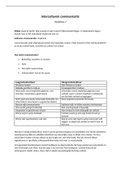Interculturele communicatie
Hoofdstuk 2
Ethiek: Goed of slecht. Wat is goed en wat is slecht? Bijvoorbeeld liegen. In Nederland is liegen
kwaad maar in het buitenland maakt het niet uit.
Indirecte communicatie: impliciete
Communicatie vindt altijd plaats binnen een bepaalde context. Maar hoeveel of hoe weinig betekenis
je uit de context haalt, verschilt van cultuur tot cultuur.
Hoe werkt communicatie?
1. Bedoeling: waarden en normen
2. Actie
3. Perceptie=waarneming
4. Interpretatie= hoe je iets opvat
Laagcontextcultuur Hoogcontextcultuur
Westerse landen Niet-Westerse landen
Individu gerichte G-Cultuur Groepsgerichte F-Cultuur
Informatie vooral explicitiet gegeven: met Informatie vooral implicitiet gegeven (non-
woorden. (Gesproken, geschreven) verbaal, want 1 woord of gebaar is voldoende
om het hele verhaal te begrijpen)
Sterk gestructureerde informatie (behoefte om Semi-ongestructureerde informatie
informatie te structuren in segmenten/delen)
Directe stijl communiceren Indirecte stijl: ze willen mensen niet kwetsen
Wat wordt gezegd is letterlijk Wat wordt gezegd is figuurlijk
Gesproken en geschreven woord Non-verbaal is even belangrijk als verbaal
Wat je zegt is wat je bedoeld Context waarin je iets zegt drukt uit wat je
bedoelt
Wat je niet zegt bedoel je ook niet Wat je soms niet zegt is wat je soms juist wilt
zeggen. Je begint bij context en werkt naar de
kern toe.
Mensen in hoogcontextcultuur leven in grote gemeenschappen en beschikken over brede netwerken
waarbij persoonlijke en zakelijke netwerken op natuurlijke wijze in elkaar over vloeien. Via hun
netwerken houden mensen elkaar op de hoogte van veel informatie. Dus als mensen elkaar
tegenkomen is specifieke achtergrondinformatie niet meer zo noodzakelijk.
In laagcontext beschrijvingen vanuit hoofdpunt en daarna details. Bij hoog context erg veel details en
veel informatie over sfeer, hoe het daar is en niet over het hoofdpunt, context (historische
achtergrond, relatie, status, sfeer, tijd en plaats) erg belangrijk bij hoog context.
Hoofdstuk 2
Ethiek: Goed of slecht. Wat is goed en wat is slecht? Bijvoorbeeld liegen. In Nederland is liegen
kwaad maar in het buitenland maakt het niet uit.
Indirecte communicatie: impliciete
Communicatie vindt altijd plaats binnen een bepaalde context. Maar hoeveel of hoe weinig betekenis
je uit de context haalt, verschilt van cultuur tot cultuur.
Hoe werkt communicatie?
1. Bedoeling: waarden en normen
2. Actie
3. Perceptie=waarneming
4. Interpretatie= hoe je iets opvat
Laagcontextcultuur Hoogcontextcultuur
Westerse landen Niet-Westerse landen
Individu gerichte G-Cultuur Groepsgerichte F-Cultuur
Informatie vooral explicitiet gegeven: met Informatie vooral implicitiet gegeven (non-
woorden. (Gesproken, geschreven) verbaal, want 1 woord of gebaar is voldoende
om het hele verhaal te begrijpen)
Sterk gestructureerde informatie (behoefte om Semi-ongestructureerde informatie
informatie te structuren in segmenten/delen)
Directe stijl communiceren Indirecte stijl: ze willen mensen niet kwetsen
Wat wordt gezegd is letterlijk Wat wordt gezegd is figuurlijk
Gesproken en geschreven woord Non-verbaal is even belangrijk als verbaal
Wat je zegt is wat je bedoeld Context waarin je iets zegt drukt uit wat je
bedoelt
Wat je niet zegt bedoel je ook niet Wat je soms niet zegt is wat je soms juist wilt
zeggen. Je begint bij context en werkt naar de
kern toe.
Mensen in hoogcontextcultuur leven in grote gemeenschappen en beschikken over brede netwerken
waarbij persoonlijke en zakelijke netwerken op natuurlijke wijze in elkaar over vloeien. Via hun
netwerken houden mensen elkaar op de hoogte van veel informatie. Dus als mensen elkaar
tegenkomen is specifieke achtergrondinformatie niet meer zo noodzakelijk.
In laagcontext beschrijvingen vanuit hoofdpunt en daarna details. Bij hoog context erg veel details en
veel informatie over sfeer, hoe het daar is en niet over het hoofdpunt, context (historische
achtergrond, relatie, status, sfeer, tijd en plaats) erg belangrijk bij hoog context.




